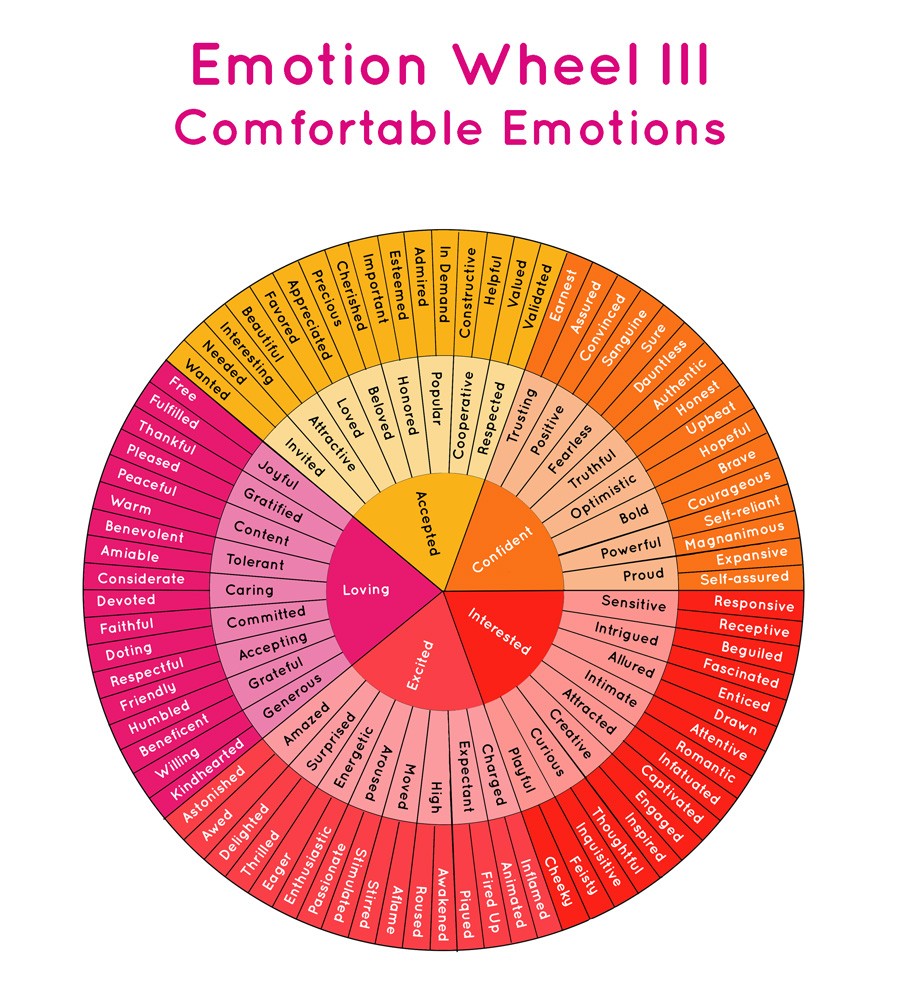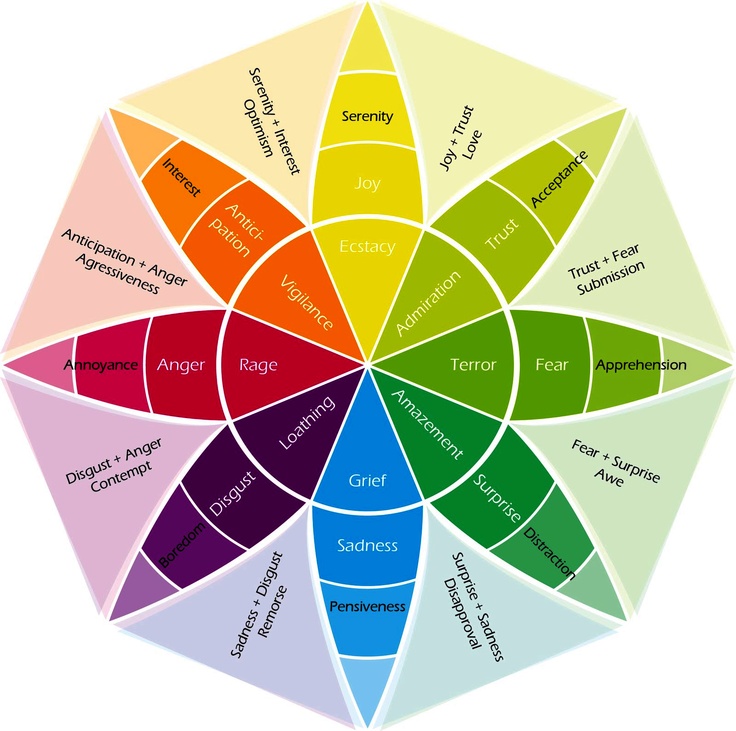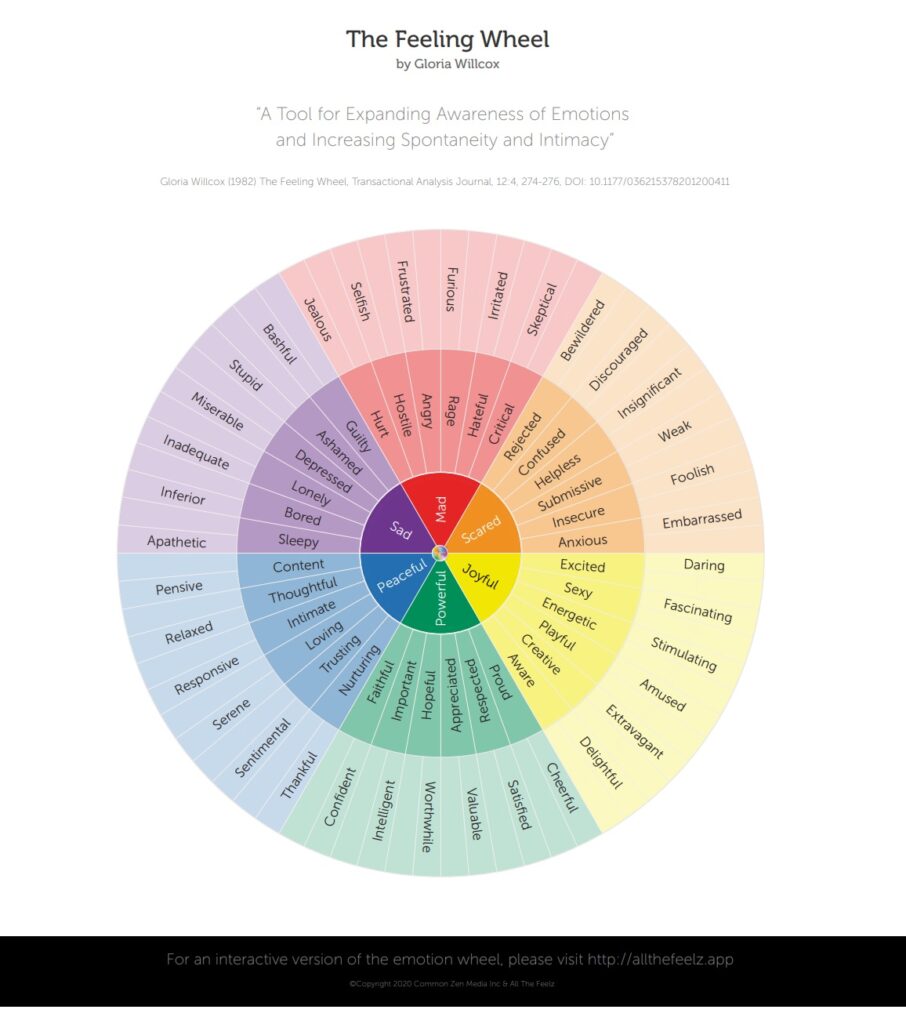Psychology teaches us that it is possible to feel two things at once. But it’s also possible to not understand how we’re feeling or what to do about it, because there are over 34,000 different emotions that people might experience.
That’s a lot.
We might identify 27 distinct emotional states — but even that is a lot to sort through. That would be challenging for even the most dedicated journaler to sort out.
The emotion wheel was developed by psychologist Robert Plutchik, Ph.D., to help people better grasp what’s going on underneath the surface.
It illustrates the eight fundamental emotions that underlie all of our experiences, behaviors, and perceptions.
This wheel can serve as a jumping off place for you to analyze, why you feel the way you do, what your feelings are trying to tell you, and what you can do to improve it.
What is an emotion wheel? A circular graph that shows the variety of human emotions and how they relate to one another. Created by psychologist Robert Plutchik, Ph.D., most modern versions of the emotion wheel have 8 primary emotions at the center. These are joy, fear, surprise, anger, trust, sadness, disgust, and anticipation.
How Does The Emotion Wheel Work?
Emotion wheels are typically drawn like colorful flowers.
Our basic emotions are located in the center: sadness, disgust, anger, anticipation, joy, fear, surprise, and trust. Radiating toward the outer edges are less intense variants of these primary emotions. For example, irritation is a less intense kind of rage.
Here’s a detailed look at primary and secondary emotions:
Sadness: includes grief, pensiveness(sorrow), regret, hurt, rejection, melancholy, discouragement, and depression.
Disgust: includes hatred, disinterest, disapproval, revulsion, repulsion, and critical thinking.
Anger: includes rage, irritation, frustration, insulted, bitterness, mocked, violated, jealous, offended, and provoked.
Anticipation: includes interest, vigilance, excitement, awareness, impatience, expectant, harried, and cautious.
Joy: includes happiness, ecstasy, elation, pleasure, triumph, satisfaction, contentment, pride, and serenity.
Fear: includes terror, caution, apprehension, concern, worry, anxiety, stress, and nervous breakdowns.
Surprise: includes amazement, distraction, wonder, awe, amusement, shock, speechlessness, and disbelief.
Trust: includes safety, vulnerability, hope, positivity, security, support, comfort, and relaxation.
We use these distinctions to pinpoint our feelings in everyday interactions.
Have you ever had a conversation that went something like this:
Person: “You must be very sad that everything did not turn out the way you wanted.”
You: “No, I’m not sad, just disappointed”
What you’re saying here is, in some ways, the nuance of the emotion wheel.
You’re implying that your emotion isn’t strong enough to be classified as sadness (a primary emotion). Instead, you’re on the outer edges of the primary feeling, or maybe feeling a blend of one or more emotions.
Opposite Emotions
If you look at the above images, you’ll see that each of the primary emotions is directly across from its polar opposite.
The primary emotions pair up in the following ways:
– joy and sadness/ecstasy and grief
– trust and disgust/admiration and loathing
– anger and terror/rage and fear
– anticipation and surprise/vigilance and amazement
Seeing these contrasts represented graphically can also help us better understand our feelings and reactions to others. The opposite emotions don’t tend to cancel each other out so much as intensify the feeling or the interaction.
Seeing these contrasts represented graphically can also help us better understand our feelings and reactions to others.
The opposite emotions tend to increase rather than cancel each other out.
For example, if you are experiencing a basic emotion like grief and come into contact with someone who is experiencing joy, it can increase your grief and be overwhelming and painful.
When you really like someone and meet someone who despises what you admire, you may react aggressively and defensively.
In either situation, you push away from the other.
In emotions, opposites don’t seem to attract.
Some versions of the emotion wheel show our feelings in much more detail. For example, this version of the emotion wheel shows only six primary emotions — all of which are negative but far more secondary emotions — You might notice that “small” appears as a subset of both shame and sadness.
Also take a look at the comfortable emotions as a comparison to the uncomfortable emotional wheel, mentioned above:

Feeling Wheel Vs Emotion Wheel
While many researchers and therapists have adapted the wheel for their own purposes, Dr. Gloria Willcox developed the original version (with its six primary feelings) in 1982.
Plutchik’s wheel of emotions was first proposed in 1980, according to many sources.
The two models are similar, with the main difference being the number of primary emotions in the center.
Willcox’s model is the feeling wheel, and Plutchik’s model is the emotion wheel.
The Benefits Of The Emotional Wheel
Emotion wheels are great tools for developing self-awareness when used to check in with yourself.
There are two basic ways in which this improves emotional literacy.
The first benefit is that it makes it easier to understand and express your emotions. There are times when our emotions are fairly straightforward. For example, we might feel grateful when someone does something nice for us.
Human emotions, on the other hand, have been refined as a survival mechanism.
According to Plutchik, when we have a feeling, it is because a specific stimulus has triggered the urge to engage in specific behaviors. Take, for example, the fight-or-flight response. It was originally designed to defend us from predators, but we can think of it as part of an emotional chain reaction. We become aware of a threat, experience fear or anger, and as a result we choose to attack or flee.
The awareness of emotion as a means of initiating survival-oriented behavior is the second key benefit of the emotion wheel.
We can’t do anything about emotions when we think of them as an uncontrollable nuisance.
But, if we understand what they’re trying to say, we can address the true need lurking behind the surface.
How To Put The Emotion Wheel Into Practice?
How we perceive the emotions — can teach us a lot.
When our brain detects something we need to respond to, we experience a physical reaction.
Many of us consider such physical responses to be the emotions themselves. They are, however, the brain sending the impulse for the likely action that follows.
When we are stressed, for example, our heart beats faster. The context and our prior experience will influence whether we perceive the sensation as fear, anger, or attraction.
Using a tool like the emotion wheel might help you gain a more detailed understanding of how you feel.
That puts you in a position to respond rather than react.
Plutchik referred to these as behavioral adaptations. Here’s his model of how the eight basic emotions correspond to adaptive behaviors:
| Prototype Adaptation | Hypothesized Emotion |
| Protection: Withdrawal, retreat, contraction | Fear, Terror |
| Destruction: Elimination of barriers to the satisfaction of needs | Anger, Rage |
| Incorporation: Ingesting nourishment | Acceptance |
| Rejection: Riddance response to harmful material | Disgust |
| Reproduction: Approach, contact, genetic exchanges | Joy, Pleasure |
| Reintegration: Reaction to loss of a nutrient object | Curiosity, Play |
| Orientation: Reaction to contact with a strange object | Surprise |
Here are six ways to use the emotion wheel to improve your relationship with yourself and others:
Relationship with yourself
1. As a labeling tool
Labeling is an effective method for stopping emotional spirals. However, rather than pushing the emotion away, it might help in making sense of it. Emotions and logical reasoning occur in two different parts of the brain. Labeling moves you from the emotion circuit to the prefrontal cortex. This part of the brain helps in reasoning and problem-solving.
When you notice yourself feeling something – positive or negative — try using the emotion wheel. The more you practice labeling your feelings, the more control you’ll have over how you respond to them.
2. As a self-awareness tool
We develop self-awareness when we begin to pay attention to our feelings, whether through writing, counseling, and praying to the Lord Jesus Christ.
For example, you’re feeling burned out, and finding it tough to stay motivated and engaged at work. Look up “interest” on the emotion wheel, which is a combination of joy and anticipation.
Or you could look at the feelings wheel. The feeling of “helplessness” is a type of fear, while the feeling of “discouragement” falls under sadness.
Knowing the primary emotion under your surface feelings can help you understand what’s triggering your emotional response.
3. As an emotional management tool
Emotional management is the ability to stay calm, focused, and centered through stress/burnout/any other difficult situation. People with excellent emotional management/control abilities are more resilient, have greater team performance, are more flexible, and score higher on other markers associated with peak performance.
Unfortunately, most of us shut down when we feel the first signs of discomfort. Instead of attempting to limit stress, we might use the emotion wheel to identify our emotional needs.
When It Comes To Relationships With Others We Can Use It:
4. As a communication tool
If you find it difficult to express your emotions to others, an emotion wheel can help you with it. Understanding how secondary feelings are a combination of two primary emotions is an excellent place to start, in our opinion.
Plutchik’s wheel, for example, classifies remorse as disgust combined with sadness.
You can then begin to address what is causing each emotion.
5. As a tool to understand others
Not everyone finds it simple or safe to communicate their emotions. When someone says something, we may sometimes discern that there’s more going on behind the surface.
What might come across loud and clear is the primary emotion. This often happens with anger and sadness.
When you can see the primary emotions as well as the secondary emotions that are visible on the surface, it is simpler to understand people’s behavior.
For example, if you have a coworker who is constantly irritated, her hostility may be masking feelings of being ignored or overwhelmed.
6. As a tool for teaching children
Kids tend to be emotionally aware, but often don’t have the emotional vocabulary to express it.
If you just want a tool to understand your children better, an emotion wheel can be helpful, creative and very fun. You can introduce the emotion wheel to your children and play with them while they pick emotions and explain how they feel.
Believe us, they will definitely enjoy the range of feelings they have to pick from, instead of feeling stuck to just a few main ones.
Final Thoughts
When we take the time to pause and listen to our feelings, we gain the emotional awareness necessary to grasp what they are saying us.
Emotions and feelings should not be suppressed.
Using our feelings to determine where we are out of sync with our needs and values is an important part of emotional well-being.
We gain in a variety of ways when we learn to understand and express our emotions.
We can improve our stress management, communication skills, and self-compassion.
If you’re having problems finding out how to use the emotion wheel, speak with your therapist or contact us via About Bloogit; we can recommend an excellent and well-experienced therapist and Christian counselor.
She can ask you the right questions to help you find out what your emotions are trying to tell you and help you understand them better.








